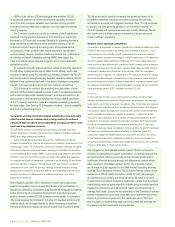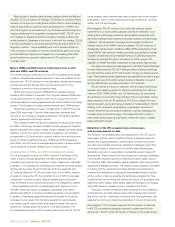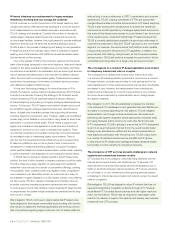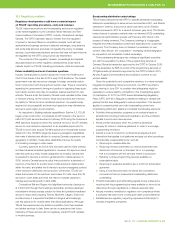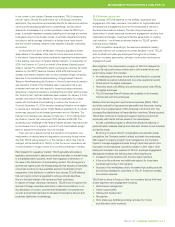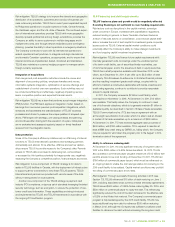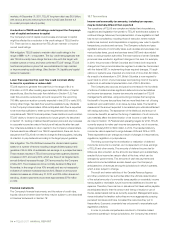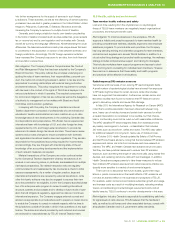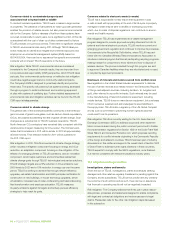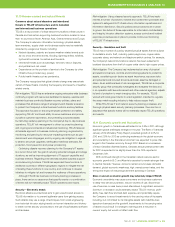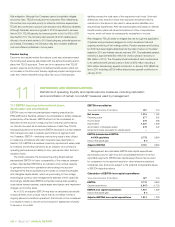Telus 2011 Annual Report Download - page 97
Download and view the complete annual report
Please find page 97 of the 2011 Telus annual report below. You can navigate through the pages in the report by either clicking on the pages listed below, or by using the keyword search tool below to find specific information within the annual report.
TELUS 2011 ANNUAL REPORT . 93
MANAGEMENT’S DISCUSSION & ANALYSIS: 10
Risk mitigation: TELUS’ strategy is to improve the diversity and geographic
distribution of its operations, customers and conduct of business pro-
cess outsourcing activities. TELUS has in recent years expanded beyond
its Philippines operations to include locations in India, Central America,
the Caribbean region and the U.S. state of Nevada. The continued expan-
sion of international operations provides TELUS with more geographic
diver sity, spreads political risk among foreign jurisdictions, provides the
Company an ability to serve customers in multiple languages and in
multiple time zones, and through network redundancy and contingency
planning, provides the ability to divert operations in emergency situa tions.
The Company continues to work with its international operations to
extend operational best practices, to integrate and align international
and domestic Canadian operations, as appropriate, and to ensure that
internal controls are implemented, tested, monitored and maintained.
TELUS also maintains a currency hedging program to manage certain
foreign currency exposures.
Integration of acquisitions
Post-merger and post-acquisition activities include the review and
alignment of accounting policies, employee transfers and moves,
information systems integration, optimization of service offerings and
establishment of control over new operations. Such activities may not
be conducted efficiently and effectively, negatively impacting service
levels, competitive position and expected financial results.
Risk mitigation: TELUS has a team that performs a post-merger integra tion
(PMI) function. The PMI team applies an integration model, based on
learnings from numerous previous post-acquisition integra tions, which
enhances and accelerates the standardization of TELUS’ business
pro cesses and strives to preserve the unique qualities of acquired oper-
ations. PMI begins with strategic, pre-closing analysis and planning,
and con tin ues after closing with the execution of a plan. Initial plans
are re-evaluated and assessed regularly, based on timely feedback
received from the integration teams.
Data protection
Some of the Company’s efficiency initiatives rely on offshoring of internal
functions to TELUS International’s operations and leveraging partners
domestically and abroad. To be effective, offshore and partner relation-
ships require TELUS to provide access to the Company’s data. Remote
access to TELUS data could lead to data being lost, compromised
or accessed by third parties potentially for inappropriate use, negatively
impacting the Company’s competitive position, financial results and brand.
Risk mitigation: A core component of TELUS’ strategy is for data to
reside in TELUS facilities in Canada, with the deployment of infrastructure
to support partner connectivity to view these TELUS systems. TELUS
International and partners are provided with remote views of the data
without it being stored on local systems.
Another core component of the TELUS strategy is payment card
industry (PCI) compliance, a rigorous set of standards leveraging the latest
security technology, such as encryption, to ensure the protection of cus-
tomer credit card information. These capabilities are being introduced
and implemented by TELUS and TELUS International in accordance with
the ongoing PCI certification program.
10.6 Financing and debt requirements
TELUS’ business plans and growth could be negatively affected
if existing financing is not sufficient to cover funding requirements
Risk factors such as disruptions in the capital markets, sovereign
credit concerns in Europe, increased bank capitalization regulations,
reduced lending in general, or fewer Canadian chartered banks as
a result of reduced activity or consolidation, could reduce capital avail-
able or increase the cost of such capital for investment grade corporate
issuers such as TELUS. External capital market conditions could
potentially affect the Company’s ability to make strategic investments
and fund ongoing capital investment requirements.
Risk mitigation: TELUS may finance future capital requirements with
internally generated funds, borrowings under the unutilized portion
of its bank credit facility, use of securitized trade receivables, use
of commercial paper, and/or the issuance of debt or equity securities.
TELUS has a shelf prospectus available until November 2013, under
which, as at December 31, 2011, it can offer up to $2.5 billion of debt
and equity. TELUS believes its adherence to its stated financial policies
and the resulting investment grade credit ratings, coupled with its
efforts to maintain a constructive relationship with banks, investors and
credit rating agencies, continue to contribute to provide reasonable
access to capital markets.
In 2011, the Company renewed a $2 billion credit facility, which
now expires on November 3, 2016. At December 31, 2011, $1.2 billion
was available. This facility allows the Company to continue to meet
one of its financial objectives, which is to generally maintain $1 billion in
available liquidity. As described in Section 7.6 Sale of trade receivables,
TELUS Communications Inc. (TCI) also has an agreement with an
arm’s-length securitization trust under which it is able to sell an interest
in certain of its trade receivables up to a maximum of $500 million.
At December 31, 2011, TCI had received aggregate cash proceeds of
$400 million, with $100 million available. TCI is required to maintain at
least a BBB (low) credit rating by DBRS Ltd., failing which, the Company
may be required to wind down the program prior to the August 1, 2014,
termination date of the agreement.
Ability to refinance maturing debt
At December 31, 2011, the only significant maturity of long-term debt in
2012 is the $300 million of 4.50% Notes due March 15, 2012. TELUS
also operates a commercial paper program (maximum of $1.2 billion) that
permits access to low-cost funding. At December 31, 2011, TELUS had
$766 million of commercial paper issued, which must be refinanced on
an ongoing basis to enable the cost savings relative to borrowing on the
2016 credit facility to be realized. Capital market conditions may prohibit
the rolling of commercial paper at low rates.
Risk mitigation: Through successful financing activities in 2011 (see
Section 7.3), TELUS refinanced $1.1 billion of debt maturing on June 1,
2011, including associated cross currency interest rate swap agree ments.
TELUS issued $600 million of 3.65% Notes maturing May 25, 2016, and
$500 million of commercial paper to repay the debt. This refinancing
significantly reduced the cost of the debt compared to the effective rate
of 8.5% on the Notes that matured. The Company’s commercial paper
program is fully backstopped by the 2016 credit facility. TELUS may
issue additional long-term debt to refinance $300 million maturing
in March 2012, although the Company has sufficient unutilized credit
facilities to refinance the debt without accessing the long-term debt



